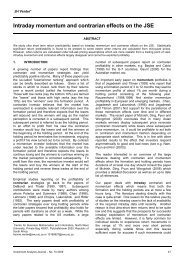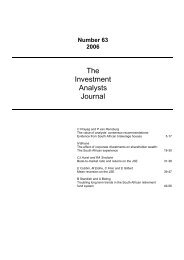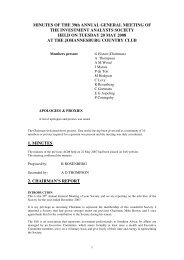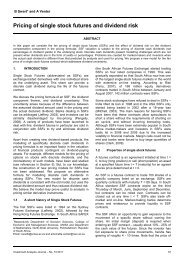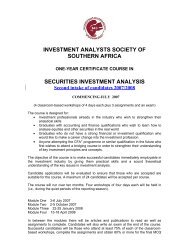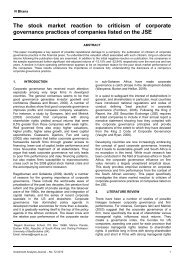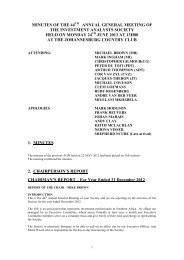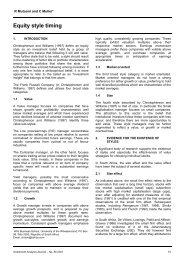Analysing some exotic options - Investment Analysts Journal
Analysing some exotic options - Investment Analysts Journal
Analysing some exotic options - Investment Analysts Journal
Create successful ePaper yourself
Turn your PDF publications into a flip-book with our unique Google optimized e-Paper software.
<strong>Analysing</strong> <strong>some</strong> <strong>exotic</strong> <strong>options</strong>: EDS, instalment shares<br />
( ≤ )<br />
P( lnS(t) lnL )<br />
P S(t) L<br />
= ≤<br />
( 1 2 2<br />
) ( 1 )<br />
⎧⎛lnS(t) ⎡ln S(0) t ⎤⎞ ⎛lnL ⎡ln S(0) t⎤⎞⎫<br />
⎪<br />
− + μ− σ − + μ− σ<br />
⎜ ⎢ 2 ⎥⎟ ⎜ ⎢ 2 ⎥⎟⎪<br />
= P<br />
⎣ ⎦ ⎣ ⎦<br />
⎨⎜ ⎟ < ⎜ ⎟⎬<br />
⎪⎜ σ t<br />
⎟ ⎜ σ t<br />
⎟⎪<br />
⎩⎝ ⎠ ⎝ ⎠⎭<br />
= P( Z (t) ≤ −0,77 ) for illustrative values of μ= 0,1; σ = 0,4; t = 1.<br />
= Φ( −0,77<br />
)<br />
= 0,22<br />
( Φ denotes the cumulative probability for the<br />
standardised normal distribution Z).<br />
Thus in this case we have a 22% probability of going<br />
through the barrier towards the end of the year. For<br />
Φ −0,35 ≈ 0,363.<br />
σ=0,6 , we have ( )<br />
For volatilities of between 40% and 60% we thus see<br />
that the probability of going through the barrier at the<br />
end of the year is roughly between 22% and 36%<br />
respectively.<br />
At t = 0,5 (mid-way through the life of the option) the<br />
probabilities are between 15% and 28% .<br />
For HotEDS, the strike is set at K = 0,75 S(0)and the<br />
barrier is set at about 0,85 S(0). The price of the option<br />
is C(0) = 0,25 S(0) +δ with a typical value for δ of 5%<br />
of S(0) (Swain, 2006). In this case the payoff when the<br />
barrier is hit is, L − K = 0,1 S(0). The loss is about<br />
67%.<br />
2.2 Exercising the option in the absence of a<br />
barrier<br />
If no barrier is present (e.g. ABSA, Nedbank, Standard<br />
Bank issued <strong>options</strong>), the option can be exercised at<br />
any time up to T = 1. If there is no barrier, it is never<br />
optimal to exercise this type of option early. If however<br />
S(T) < K the option expires worthless. Your loss is then<br />
100% and the option cannot be rolled over.<br />
Suppose the option is exercised at time t*, and the<br />
shares received in return for payment K.<br />
The payoff in this case is:<br />
S(t*) − K, … (3)<br />
and the gain (profit/loss) to the holder is:<br />
S(t*) - K - C(0) ≈ S(t*) - S(0) - δ.<br />
From this it follows that a profit is made by buying the<br />
share in instalments only if at <strong>some</strong> time t* we have<br />
S t* > S 0 +δ,<br />
( ) ( )<br />
that is, only if<br />
S( t* ) > S( 0)[ 1+<br />
0,05 ]. (Assuming δ=0,05 S(0).)<br />
This means a 5% increase in share price is needed for<br />
a profit. The percentage gain, defined as [ S(t*) – K –<br />
C(0)] / C(0), will then be about<br />
( ) ( )<br />
1, 81 ⎡⎣<br />
S t * /S 0 ⎤− ⎦ 1, 91.<br />
Compare this with the case of owning the share where<br />
a profit is made if S(t*) > S(0) and the percentage<br />
profit is [S(t*) / S(0)] - 1.<br />
The return on owning the EDS is larger than that of<br />
owning the share if<br />
S(t*) > 1,1235 S(0) .<br />
This means a 12,35% increase in share price is<br />
needed for the instalment option to become more<br />
profitable than holding the share itself. However,<br />
buying the option does require a smaller outlay than<br />
buying the share.<br />
Irrespective of when you exercise the option you will<br />
have paid S(0) + δ for the share, ignoring time value of<br />
money. It will be better to exercise after you have<br />
received dividends. As with American <strong>options</strong> on<br />
shares with no dividends, early exercise does not<br />
seem to be advisable.<br />
If the option ends in the money and is not exercised, a<br />
cash settlement of S(T) – K is made.<br />
Note 1: S(T) actually refers to the 2-day simple<br />
average of the daily volume weighted average price.<br />
We shall simply denote all share prices by<br />
S(t), 0 ≤ t ≤ T.<br />
Note 2: If there is in fact a barrier in place early<br />
exercise may be advisable when the share price is<br />
heading for the barrier. The option is still deep-in-themoney<br />
at this stage and may be worth exercising.<br />
2.3 Selling the option instead of exercising<br />
If the object is to speculate and not to acquire the<br />
share, it may be better to sell the option before<br />
maturity. The option can be sold at any time with the<br />
market maker providing a bid/offer spread. The<br />
theoretical (fair) price of the option will be discussed in<br />
Section 3. Transaction costs and the size of the market<br />
maker’s spread will determine the profitability of selling<br />
the option.<br />
52 <strong>Investment</strong> <strong>Analysts</strong> <strong>Journal</strong> – No. 67 2008




